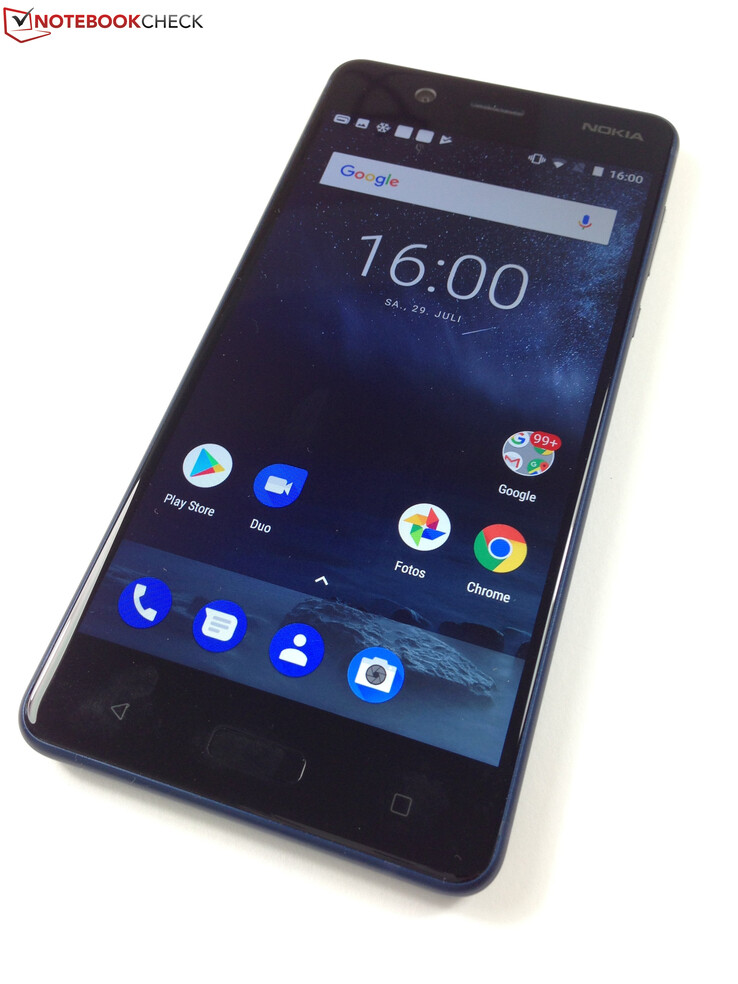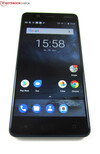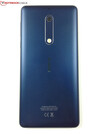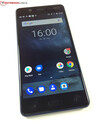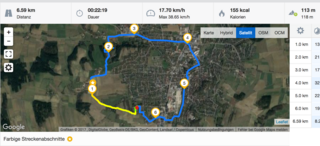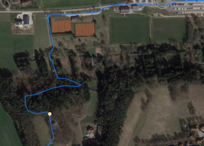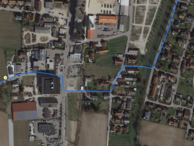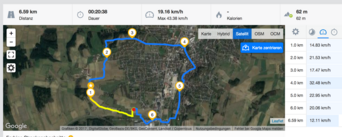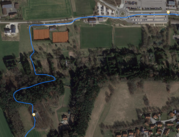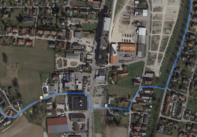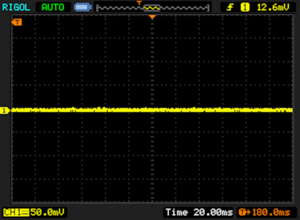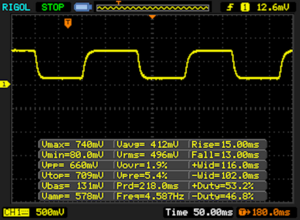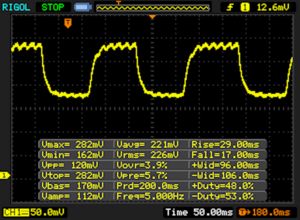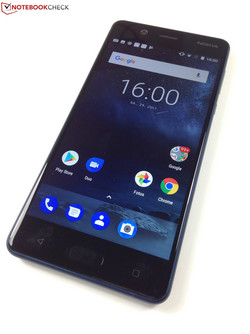Breve Análise do Smartphone Nokia 5
Os Top 10
» Os Top 10 Portáteis Multimídia
» Os Top 10 Portáteis de Jogos
» Os Top 10 Portáteis Leves para Jogos
» Os Top 10 Portáteis Acessíveis de Escritório/Empresariais
» Os Top 10 Portáteis Premium de Escritório/Empresariais
» Os Top 10 dos Portáteis Workstation
» Os Top 10 Subportáteis
» Os Top 10 Ultrabooks
» Os Top 10 Conversíveis
» Os Top 10 Tablets
» Os Top 10 Smartphones
» A melhores Telas de Portáteis Analisadas Pela Notebookcheck
» Top 10 dos portáteis abaixo dos 500 Euros da Notebookcheck
» Top 10 dos Portáteis abaixo dos 300 Euros
Size comparison
| Networking | |
| iperf3 transmit AX12 | |
| Nokia 5 | |
| Lenovo Moto G5 | |
| Wiko U Feel Prime | |
| Lenovo K6 | |
| iperf3 receive AX12 | |
| Nokia 5 | |
| Lenovo Moto G5 | |
| Wiko U Feel Prime | |
| Lenovo K6 | |
| |||||||||||||||||||||||||
iluminação: 90 %
iluminação com acumulador: 630 cd/m²
Contraste: 1105:1 (Preto: 0.57 cd/m²)
ΔE ColorChecker Calman: 5 | ∀{0.5-29.43 Ø4.78}
ΔE Greyscale Calman: 6.9 | ∀{0.09-98 Ø5}
97.6% sRGB (Calman 2D)
Gamma: 2.37
CCT: 8736 K
| Nokia 5 IPS, 1280x720, 5.2" | Lenovo K6 IPS, 1920x1080, 5" | Samsung Galaxy J5 2016 AMOLED, 1280x720, 5.2" | Lenovo Moto G5 IPS, 1920x1080, 5" | Wiko U Feel Prime IPS, 1920x1080, 5" | |
|---|---|---|---|---|---|
| Screen | -0% | -4% | 26% | 6% | |
| Brightness middle (cd/m²) | 630 | 470 -25% | 289 -54% | 660 5% | 411 -35% |
| Brightness (cd/m²) | 635 | 461 -27% | 291 -54% | 625 -2% | 386 -39% |
| Brightness Distribution (%) | 90 | 88 -2% | 96 7% | 92 2% | 86 -4% |
| Black Level * (cd/m²) | 0.57 | 0.38 33% | 0.29 49% | 0.36 37% | |
| Contrast (:1) | 1105 | 1237 12% | 2276 106% | 1142 3% | |
| Colorchecker dE 2000 * | 5 | 5.2 -4% | 4.7 6% | 4.9 2% | 4.3 14% |
| Colorchecker dE 2000 max. * | 8.7 | 9.5 -9% | 7.3 16% | 7.6 13% | 7.9 9% |
| Greyscale dE 2000 * | 6.9 | 5.6 19% | 3 57% | 4.8 30% | 2.8 59% |
| Gamma | 2.37 93% | 2.24 98% | 2.03 108% | 2.18 101% | 2.53 87% |
| CCT | 8736 74% | 7924 82% | 6291 103% | 7357 88% | 6589 99% |
* ... menor é melhor
Cintilação da tela / PWM (modulação por largura de pulso)
| Tela tremeluzindo / PWM não detectado | |||
[pwm_comparison] Em comparação: 53 % de todos os dispositivos testados não usam PWM para escurecer a tela. Se PWM foi detectado, uma média de 8111 (mínimo: 5 - máximo: 343500) Hz foi medida. | |||
Exibir tempos de resposta
| ↔ Tempo de resposta preto para branco | ||
|---|---|---|
| 28 ms ... ascensão ↗ e queda ↘ combinadas | ↗ 15 ms ascensão | |
| ↘ 13 ms queda | ||
| A tela mostra taxas de resposta relativamente lentas em nossos testes e pode ser muito lenta para os jogadores. Em comparação, todos os dispositivos testados variam de 0.1 (mínimo) a 240 (máximo) ms. » 70 % de todos os dispositivos são melhores. Isso significa que o tempo de resposta medido é pior que a média de todos os dispositivos testados (20.2 ms). | ||
| ↔ Tempo de resposta 50% cinza a 80% cinza | ||
| 46 ms ... ascensão ↗ e queda ↘ combinadas | ↗ 29 ms ascensão | |
| ↘ 17 ms queda | ||
| A tela mostra taxas de resposta lentas em nossos testes e será insatisfatória para os jogadores. Em comparação, todos os dispositivos testados variam de 0.165 (mínimo) a 636 (máximo) ms. » 78 % de todos os dispositivos são melhores. Isso significa que o tempo de resposta medido é pior que a média de todos os dispositivos testados (31.6 ms). | ||
| AnTuTu v6 - Total Score (classificar por valor) | |
| Nokia 5 | |
| Lenovo K6 | |
| Samsung Galaxy J5 2016 | |
| Lenovo Moto G5 | |
| Wiko U Feel Prime | |
| PCMark for Android | |
| Work performance score (classificar por valor) | |
| Nokia 5 | |
| Lenovo K6 | |
| Samsung Galaxy J5 2016 | |
| Lenovo Moto G5 | |
| Wiko U Feel Prime | |
| Work 2.0 performance score (classificar por valor) | |
| Nokia 5 | |
| Samsung Galaxy J5 2016 | |
| Lenovo Moto G5 | |
| Geekbench 4.4 | |
| 64 Bit Single-Core Score (classificar por valor) | |
| Nokia 5 | |
| Samsung Galaxy J5 2016 | |
| Lenovo Moto G5 | |
| 64 Bit Multi-Core Score (classificar por valor) | |
| Nokia 5 | |
| Samsung Galaxy J5 2016 | |
| Lenovo Moto G5 | |
| Compute RenderScript Score (classificar por valor) | |
| Samsung Galaxy J5 2016 | |
| Lenovo Moto G5 | |
| GFXBench (DX / GLBenchmark) 2.7 | |
| T-Rex Onscreen (classificar por valor) | |
| Nokia 5 | |
| Lenovo K6 | |
| Samsung Galaxy J5 2016 | |
| Lenovo Moto G5 | |
| Wiko U Feel Prime | |
| 1920x1080 T-Rex Offscreen (classificar por valor) | |
| Nokia 5 | |
| Lenovo K6 | |
| Samsung Galaxy J5 2016 | |
| Lenovo Moto G5 | |
| Wiko U Feel Prime | |
| GFXBench 3.0 | |
| on screen Manhattan Onscreen OGL (classificar por valor) | |
| Nokia 5 | |
| Lenovo K6 | |
| Samsung Galaxy J5 2016 | |
| Lenovo Moto G5 | |
| Wiko U Feel Prime | |
| 1920x1080 1080p Manhattan Offscreen (classificar por valor) | |
| Nokia 5 | |
| Lenovo K6 | |
| Samsung Galaxy J5 2016 | |
| Lenovo Moto G5 | |
| Wiko U Feel Prime | |
| GFXBench 3.1 | |
| on screen Manhattan ES 3.1 Onscreen (classificar por valor) | |
| Nokia 5 | |
| Lenovo K6 | |
| Samsung Galaxy J5 2016 | |
| Lenovo Moto G5 | |
| Wiko U Feel Prime | |
| 1920x1080 Manhattan ES 3.1 Offscreen (classificar por valor) | |
| Nokia 5 | |
| Lenovo K6 | |
| Samsung Galaxy J5 2016 | |
| Lenovo Moto G5 | |
| Wiko U Feel Prime | |
| GFXBench | |
| on screen Car Chase Onscreen (classificar por valor) | |
| Nokia 5 | |
| Lenovo K6 | |
| Samsung Galaxy J5 2016 | |
| Lenovo Moto G5 | |
| Wiko U Feel Prime | |
| 1920x1080 Car Chase Offscreen (classificar por valor) | |
| Nokia 5 | |
| Lenovo K6 | |
| Samsung Galaxy J5 2016 | |
| Lenovo Moto G5 | |
| Wiko U Feel Prime | |
| JetStream 1.1 - Total Score | |
| Nokia 5 | |
| Lenovo K6 | |
| Wiko U Feel Prime | |
| Lenovo Moto G5 | |
| Samsung Galaxy J5 2016 | |
| Octane V2 - Total Score | |
| Lenovo K6 | |
| Wiko U Feel Prime | |
| Nokia 5 | |
| Samsung Galaxy J5 2016 | |
| Lenovo Moto G5 | |
| Mozilla Kraken 1.1 - Total | |
| Samsung Galaxy J5 2016 | |
| Lenovo Moto G5 | |
| Lenovo K6 | |
| Wiko U Feel Prime | |
| Nokia 5 | |
| WebXPRT 2015 - Overall | |
| Lenovo Moto G5 | |
| Nokia 5 | |
| Samsung Galaxy J5 2016 | |
| Lenovo K6 | |
* ... menor é melhor
| Nokia 5 | Lenovo K6 | Samsung Galaxy J5 2016 | Lenovo Moto G5 | Wiko U Feel Prime | |
|---|---|---|---|---|---|
| AndroBench 3-5 | -10% | -14% | 47% | 7% | |
| Sequential Read 256KB (MB/s) | 255.6 | 262.6 3% | 147 -42% | 230.6 -10% | 270.9 6% |
| Sequential Write 256KB (MB/s) | 74.9 | 46.66 -38% | 72 -4% | 45.6 -39% | 137.3 83% |
| Random Read 4KB (MB/s) | 40.54 | 32.01 -21% | 21 -48% | 37.6 -7% | 55 36% |
| Random Write 4KB (MB/s) | 8.39 | 10.5 25% | 11.6 38% | 37.9 352% | 9.4 12% |
| Sequential Read 256KB SDCard (MB/s) | 83.9 | 78.2 -7% | 79.8 -5% | 78.5 -6% | 41.98 -50% |
| Sequential Write 256KB SDCard (MB/s) | 62 | 50.4 -19% | 46.61 -25% | 58 -6% | 35.21 -43% |
| Dead Trigger 2 | |||
| Configurações | Valor | ||
| high | 54 fps | ||
| Asphalt 8: Airborne | |||
| Configurações | Valor | ||
| high | 30 fps | ||
| very low | 30 fps | ||
(+) A temperatura máxima no lado superior é 36.9 °C / 98 F, em comparação com a média de 35.2 °C / 95 F , variando de 21.9 a 247 °C para a classe Smartphone.
(+) A parte inferior aquece até um máximo de 35.2 °C / 95 F, em comparação com a média de 34 °C / 93 F
(+) Em uso inativo, a temperatura média para o lado superior é 30.2 °C / 86 F, em comparação com a média do dispositivo de 32.9 °C / ### class_avg_f### F.
Nokia 5 análise de áudio
(+) | os alto-falantes podem tocar relativamente alto (###valor### dB)
Graves 100 - 315Hz
(-) | quase nenhum baixo - em média 19.5% menor que a mediana
(±) | a linearidade dos graves é média (10.4% delta para a frequência anterior)
Médios 400 - 2.000 Hz
(+) | médios equilibrados - apenas 4.3% longe da mediana
(+) | médios são lineares (3.6% delta para frequência anterior)
Altos 2 - 16 kHz
(+) | agudos equilibrados - apenas 4.7% longe da mediana
(+) | os máximos são lineares (3.7% delta da frequência anterior)
Geral 100 - 16.000 Hz
(±) | a linearidade do som geral é média (19.4% diferença em relação à mediana)
Comparado com a mesma classe
» 27% de todos os dispositivos testados nesta classe foram melhores, 8% semelhantes, 65% piores
» O melhor teve um delta de 11%, a média foi 35%, o pior foi 134%
Comparado com todos os dispositivos testados
» 47% de todos os dispositivos testados foram melhores, 7% semelhantes, 46% piores
» O melhor teve um delta de 4%, a média foi 24%, o pior foi 134%
Samsung Galaxy J5 2016 análise de áudio
(+) | os alto-falantes podem tocar relativamente alto (###valor### dB)
Graves 100 - 315Hz
(-) | quase nenhum baixo - em média 32.6% menor que a mediana
(±) | a linearidade dos graves é média (7.1% delta para a frequência anterior)
Médios 400 - 2.000 Hz
(±) | médios mais altos - em média 7.6% maior que a mediana
(±) | a linearidade dos médios é média (10.9% delta para frequência anterior)
Altos 2 - 16 kHz
(±) | máximos mais altos - em média 6.1% maior que a mediana
(+) | os máximos são lineares (6.5% delta da frequência anterior)
Geral 100 - 16.000 Hz
(-) | o som geral não é linear (30.2% diferença em relação à mediana)
Comparado com a mesma classe
» 78% de todos os dispositivos testados nesta classe foram melhores, 4% semelhantes, 18% piores
» O melhor teve um delta de 11%, a média foi 35%, o pior foi 134%
Comparado com todos os dispositivos testados
» 88% de todos os dispositivos testados foram melhores, 3% semelhantes, 9% piores
» O melhor teve um delta de 4%, a média foi 24%, o pior foi 134%
Lenovo K6 análise de áudio
(+) | os alto-falantes podem tocar relativamente alto (###valor### dB)
Graves 100 - 315Hz
(-) | quase nenhum baixo - em média 25.8% menor que a mediana
(±) | a linearidade dos graves é média (9.1% delta para a frequência anterior)
Médios 400 - 2.000 Hz
(±) | médios reduzidos - em média 9.3% menor que a mediana
(+) | médios são lineares (6.9% delta para frequência anterior)
Altos 2 - 16 kHz
(+) | agudos equilibrados - apenas 3.9% longe da mediana
(+) | os máximos são lineares (4.9% delta da frequência anterior)
Geral 100 - 16.000 Hz
(±) | a linearidade do som geral é média (23.5% diferença em relação à mediana)
Comparado com a mesma classe
» 53% de todos os dispositivos testados nesta classe foram melhores, 8% semelhantes, 39% piores
» O melhor teve um delta de 11%, a média foi 35%, o pior foi 134%
Comparado com todos os dispositivos testados
» 69% de todos os dispositivos testados foram melhores, 6% semelhantes, 24% piores
» O melhor teve um delta de 4%, a média foi 24%, o pior foi 134%
| desligado | |
| Ocioso | |
| Carga |
|
Key:
min: | |
| Nokia 5 3000 mAh | Lenovo K6 3000 mAh | Samsung Galaxy J5 2016 3100 mAh | Lenovo Moto G5 2800 mAh | Wiko U Feel Prime 3000 mAh | |
|---|---|---|---|---|---|
| Power Consumption | -6% | 17% | -10% | -0% | |
| Idle Minimum * (Watt) | 0.52 | 0.65 -25% | 0.61 -17% | 0.73 -40% | 0.66 -27% |
| Idle Average * (Watt) | 1.78 | 1.65 7% | 1.41 21% | 1.64 8% | 1.66 7% |
| Idle Maximum * (Watt) | 1.96 | 1.67 15% | 1.51 23% | 1.68 14% | 1.76 10% |
| Load Average * (Watt) | 3.23 | 3.58 -11% | 2.56 21% | 3.46 -7% | 2.85 12% |
| Load Maximum * (Watt) | 4.88 | 5.58 -14% | 3.1 36% | 6.13 -26% | 5.01 -3% |
* ... menor é melhor
| Nokia 5 3000 mAh | Lenovo K6 3000 mAh | Samsung Galaxy J5 2016 3100 mAh | Lenovo Moto G5 2800 mAh | Wiko U Feel Prime 3000 mAh | |
|---|---|---|---|---|---|
| Duração da bateria | -5% | -3% | -27% | -24% | |
| Reader / Idle (h) | 29.5 | 27.1 -8% | 26.7 -9% | 20.7 -30% | 20.9 -29% |
| H.264 (h) | 13.2 | 10.6 -20% | 11 -17% | 10.3 -22% | |
| WiFi v1.3 (h) | 11.9 | 11.9 0% | 10.7 -10% | 9.4 -21% | 9.6 -19% |
| Load (h) | 5.4 | 5.8 7% | 6.7 24% | 3.5 -35% |
Pro
Contra
Você não pode esperar muito de um smartphone listado por 200 Euros (~ $236), ou pode? O Nokia 5 prova exatamente o contrário, oferecendo bastante em termos de recursos e desempenho. Você recebe um veloz SoC octa-core Qualcomm Snapdragon 430, uma tela HD muito brilhante, LTE Cat.4 cobrindo uma ampla gama de bandas de frequência e uma boa câmera de 13 MP. A versão atual do Android 7.1, uma longa duração da bateria e a elegante carcaça de alumínio, incluindo um sensor de digitais, também falam pelo Nokia 5.
O rápido, bem construído e elegante Nokia 5 é um bom smartphone de gama média, que oferece muito por um preço relativamente baixo.
Em termos de armazenamento de memória, os compradores devem diminuir as suas expectativas, dado que infelizmente não são possíveis mais de 16 GB. O fabricante também não incluiu um conector USB Type-C que teria evitado inseri-lo da maneira errada. Além disso, o Nokia 5 adiciona um leve matiz azul à sua tela nítida e mostra alguns halos de luz na parte inferior e bordas em particular com o brilho máximo da tela. No entanto, no geral, a Nokia acerta em mais coisas das que erra e, portanto, merece uma recomendação.
Nokia 5
- 08/01/2017 v6 (old)
Manuel Masiero




